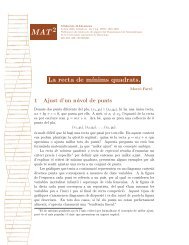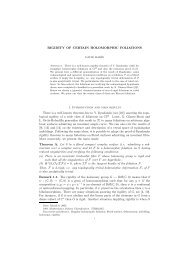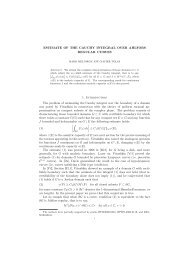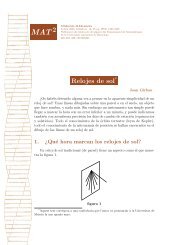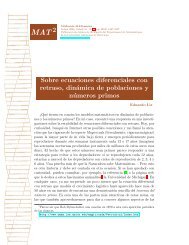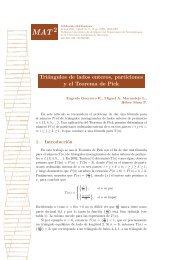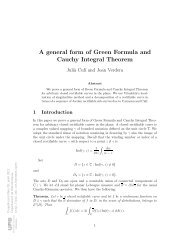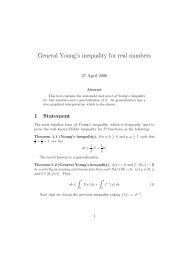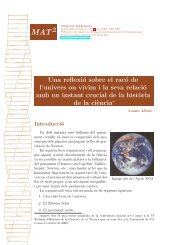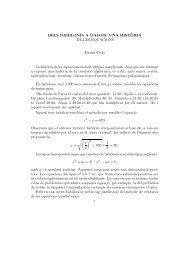ASPECTS OF IWASAWA THEORY OVER FUNCTION FIELDS 1 ...
ASPECTS OF IWASAWA THEORY OVER FUNCTION FIELDS 1 ...
ASPECTS OF IWASAWA THEORY OVER FUNCTION FIELDS 1 ...
Create successful ePaper yourself
Turn your PDF publications into a flip-book with our unique Google optimized e-Paper software.
<strong>IWASAWA</strong> <strong>THEORY</strong> <strong>OVER</strong> <strong>FUNCTION</strong> <strong>FIELDS</strong> 5Theorem 2.3. In the above setting assume that F d /F is unramified outside a finite set ofplaces of F and that E has good ordinary or split multiplicative reduction at all ramified places.Then Ker a L is finite (of order bounded independently of L) and Coker a L is a cofinitelygenerated Z p -module (of bounded corank if d = 1). Moreover if all places of bad reduction forE are unramified in F d /F then Coker a L is finite as well (of bounded order if d = 1).Proof. Let F w be the completion of F d at w and, to shorten notations, let⎧⎫⎨G(X L ) := Im⎩ H1 fl (X L, E[p ∞ ]) −→∏⎬Hfl 1 (X L v, E[p ∞ ])/Im κ Lv⎭v∈M L(analogous definition for G(X Fd ) ).Consider the diagramSel E (L) p H 1 fl (X L, E[p ∞ ]) G(X L )a LSel E (F d ) Γ Lp b L H 1 fl (X F d, E[p ∞ ]) Γ L G(X Fd ) Γ L.Since X Fd /X L is a Galois covering the Hochschild-Serre spectral sequence (see [33, III.2.21a),b) and III.1.17 d)]) yieldsKer b L = H 1 (Γ L , E[p ∞ ](F d )) and Coker b L ⊆ H 2 (Γ L , E[p ∞ ](F d ))(where the H i ’s are Galois cohomology groups). Since E[p ∞ ](F d ) is finite it is easy to seethat|Ker b L | ≤ |E[p ∞ ](F d )| d and |Coker b L | ≤ |E[p ∞ ](F d )| d(d−1)2([2, Lemma 4.1]). By the snake lemma the inequality on the left is enough to prove the firststatement of the theorem, i.e.,|Ker a L | ≤ |Ker b L | ≤ |E[p ∞ ](F d )| dwhich is finite and bounded independently of L (actually one can also use the upper bound|E[p ∞ ](F sep )| d which makes it independent of F d as well).We are left with Ker c L : for any place w of F d dividing v defineThend w : H 1 fl (X L v, E[p ∞ ])/Im κ Lv −→ H 1 fl (X F w, E[p ∞ ])/Im κ w .Ker c L ↩→∏ ⋂Ker d wv∈M L(note also that Ker d w really depends on v and not on w). If v totally splits in F d /L then d wis obviously an isomorphism. Therefore from now on we study the Ker d w ’s only for primeswhich are not totally split. Moreover, because of the following diagram coming from theKummer exact sequenceHfl 1 (X L v, E[p ∞ ])/Im κ Lv Hfl 1 (X L v, E)w|vc Ld wH 1 fl (X F w, E[p ∞ ])/Im κ Fw h w H 1 fl (X F w, E) ,one has an injectionwhich allows us to focus on H 1 (Γ Lv , E(F w )).Ker d w ↩→ Ker h w ≃ H 1 (Γ Lv , E(F w ))



